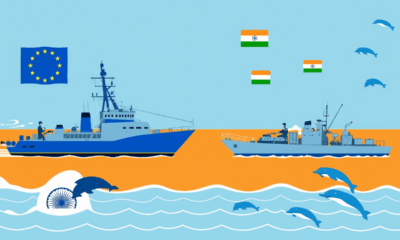Travel
Selfies are more lethal than shark attacks. Should more tourist destinations ban them?
Selfie bans are becoming more common in popular tourist spots. Here’s how they save lives.
The selfie craze is now more lethal than shark attacks. A study published in the Journal of Travel Medicine in 2022 uncovered 379 selfie-related deaths over the previous 13 years.
Among these, 140 tourists tragically snapped their final photo. Meanwhile, only 90 fatal encounters during the same time frame involved sharks, primarily unprovoked.
Just last month, a gondola capsized in Venice, Italy when a group of tourists refused to stop taking selfies and sit down. Right before the accident, the gondolier asked the group not to move around while he attempted a tricky manoeuvre under a low bridge. Thankfully, no one was injured.
The pursuit of the perfect selfie for social media has led tourists into a realm of extreme risks, resulting in tragic incidents, including fatal falls from cliffs, accidents with cars and trains, dangerous wildlife encounters, and unforeseen drownings.
As a result, tourists are now being hit with hefty fines and jail time for engaging in the dangerous, disruptive, and destructive action of taking selfies too far.
In December, a 24-year-old woman was tragically killed while attempting to take a selfie on the edge of the Prabalgad Fort in India. She fell 60 metres into a gorge.
During the 2023 Tour de France, a spectator attempting to take a selfie with passing riders clipped the handlebars of an American cyclist, causing a 20-rider pile-up during the 15th stage of the race.
Portofino in northern Italy placed a temporary selfie ban in some areas of the city last year to prevent overcrowding on its narrow streets. The ban was enacted after what was described as ‘anarchic chaos’ caused by tourists blocking traffic to take photos.
Risking your life for the perfect photo
Taking the perfect photo for social media often leads to risky behaviour fuelled by the desire to stand out in a crowded landscape. Spurred by the desire for likes, shares and fame, dangerous selfies continue to increase in popularity. The quest for the best photo can lead individuals to ignore safety warnings or venture into unsafe places.
Of the 379 selfie-related deaths worldwide between 2008 and 2021, 37.2 per cent were travellers, as opposed to locals. Falls from height made up 49.9 per cent of all deaths, followed by transport-related (28.4 per cent) and drownings (15.3 per cent).
The average age of selfie victims during this time period was 24.4 years old. Women were more likely to be fatally injured in falls from heights and animal encounters, while more men were killed in transport-related risks. Countries with the highest number of selfie deaths included India (26.4 per cent), the United States (10.3 per cent), and Russia (8.7 per cent).
What’s worse, according to a study by the Journal of Family Medicine and Primary Care, selfie-related deaths are most likely underreported as they are not usually listed as the cause of death.
Dangerous selfies are a public health issue
According to scientific analysis from the University of New South Wales (UNSW) in Sydney, Australia, the media tends to portray dangerous selfie-taking as foolish and selfish, often blaming the victim. However, selfies are now a regular part of everyday life, and these scientists assert that the act of taking risky selfies should be addressed as a public health issue.
Similarly, previous generations considered driving without a seatbelt, riding a bike without a helmet, and smoking cigarettes ‘normal’ everyday activities that are now public health hazards.
By recognising these risky behaviours as public health issues, we stop blaming and shaming and instead begin to take steps toward prevention and education.
This would be a step further than past decisions to designate dangerous tourist areas, such as bodies of water, mountain peaks, and tall buildings, as ‘no selfie zones’.
The destinations restricting selfie taking
Japan’s JR West Railway Company banned selfie sticks on its platforms to prevent electrocutions from overhead wiring and falling onto the tracks.
After a string of selfie-related accidents in Mumbai, India, the government enacted no selfie zones in certain areas of the city, including some beaches, festival sites and tourist attractions. In Pamplona, Spain, taking selfies during the annual Running of the Bulls is illegal due to previous gorgings.
In the United States, New York passed a bill banning selfies with wildcats unless there is a physical barrier between the person and the animal. Similarly, visitors to Lake Tahoe have been asked not to take bear selfies, as turning your back near a bear is extremely dangerous.
The popularity of selfies, especially among younger demographics, led to a rise in accidents and fatalities.
Some places have implemented warning signs, restricted access to hazardous areas and conducted awareness campaigns. But these steps may not fully address the underlying issue of risk-taking behaviour for the sake of social media recognition.
More effective and innovative approaches need to be implemented to address this modern-day safety concern.
Travel
Wildfire warnings issued in the Canary Islands as millions prepare to holiday there
ADVERTISEMENT
As millions of holidaymakers prepare to head to the Canary Islands this summer, authorities have issued a wildfire pre-alert across the archipelago.
The warning, announced by the General Directorate of Emergencies on Sunday, applies to tourist hotspots El Hierro, La Palma, La Gomera, Tenerife and Gran Canaria.
It comes as the islands enter a high-risk fire period following the wet season, as hot, dry winds known as the ‘calima’ begin blowing in from the Sahara Desert.
Fires are common, but they haven’t slowed tourism
The risk of wildfire is nothing new for the Canary Islands.
The volcanic terrain, Mediterranean climate and fire-adapted vegetation – plants that have evolved to thrive in fire-prone environments – make them susceptible to summer blazes, and scientists say wildfires are part of the archipelago’s ecological rhythm.
Some of the worst occurred in 2023, when forest fires ravaged Tenerife, destroying more than 15,000 hectares of land and forcing 12,000 people to evacuate. The blaze was later found to have been started by arsonists.
This year, officials are urging tourists and locals alike to take extreme caution, warning against launching fireworks near forests and discarding cigarettes on dry ground.
But even as the fire warnings roll in, the Canaries’ appeal shows no signs of slowing down.
In 2024, the islands welcomed nearly 18 million tourists, including a record-breaking 15.5 million international arrivals. Among them, British travellers led the way, recording 6.3 million visits – up 500,000 from 2023.
Concerns about overtourism mount amid record arrivals
While the Canary Islands continue to attract record numbers of tourists, residents are increasingly voicing concerns about overtourism.
In April 2024, tens of thousands of islanders participated in protests, holding signs that read “the Canary Islands have a limit” while rallying against rising housing costs, environmental damage and the strain on public services.
Over Easter this year, about 80,000 hospitality workers in Tenerife, La Palma, La Gomera and El Hierrowalked out in a dispute with unions over pay.
The surge in short-term rentals has been especially contentious. Locals have reported getting priced out of their neighbourhoods as properties are converted into holiday lets, the cost of living soars and wages stagnate.
Despite these concerns, tourism remains a significant part of the Canary Islands’ economy, accounting for approximately 35 per cent of its GDP.
Tenerife still reigns supreme
After welcoming seven million tourists in 2024, Tenerife remains the most visited island.
Its year-round sunshine and wide beaches keep it a firm favourite among families, especially during the UK’s summer school break and throughout the winter months.
As the peak summer season picks up, local tourism boards have made no indication that the fire pre-alerts will disrupt travel plans.
But authorities remain focused on prevention this year.
More than 2,000 firefighters are on standby. Meanwhile, the government has distributed detailed safety advice, urging people to prepare a go-bag, stay informed and follow emergency evacuation or shelter-in-place instructions if fires erupt.
Travel
Violent turbulence hits Ryanair flight in Germany, forcing an emergency landing and injuring 9
By Euronews Travel with AP
Published on
ADVERTISEMENT
Severe storms in southern Germany forced a Ryanair flight to make an emergency landing late Wednesday after violent turbulence injured nine people on board, German police said in a statement Thursday.
The flight, travelling from Berlin to Milan with 179 passengers and six crew members, encountered turbulence so intense around 8:30 pm that the pilot was forced to make an unscheduled landing at Memmingen Airport in Bavaria.
Eight passengers and one crew member were hurt.
Three people were taken to the hospital in Memmingen for treatment; the other injured people were released after receiving outpatient treatment. As a precaution, all passengers were checked for injuries by the emergency services.
Authorities did not permit the plane to continue flying, and the airline arranged bus transport for passengers. Milan is about 380 kilometres south of Memmingen.
More bad weather expected in Germany
Elsewhere in the region, storms damaged several homes in Ulm, Baden-Württmberg, according to the German news agency dpa.
In the Donaustetten district, strong winds tore roofs off multiple row houses, rendering them uninhabitable, though no injuries were reported. Fire officials suspect a small tornado or waterspout caused the damage. The German Weather Service (DWD) is investigating, according to dpa.
Storm-related emergency calls also came from other areas in southern Germany, where damage was mostly limited to fallen trees and flooded basements.
The DWD warned of further storms on Thursday, 5 June, with hail, strong winds, and localised heavy rain expected.
Travel
Hikers ignored warnings before Mount Etna’s latest eruption, Sicilian officials say
Published on
ADVERTISEMENT
Despite warnings to stay away, hikers on Mount Etna were forced to flee this week after Italy’s most active volcano erupted.
Footage from the mountain shared on social media showed tourists scurrying down the slopes as ash rose into the sky. Authorities had issued alerts on Monday morning after signs of increased volcanic activity, but dozens ignored them and climbed toward the summit anyway.
“There was a big explosion and a crater collapsed but luckily it fell into a deserted area,” said Salvo Cocina, head of Sicily’s Civil Protection Department. “It’s very hard to block access [to Mount Etna] – you can’t fence it off.”
No one was injured and the alert level was lowered to the standard ‘yellow’ on Tuesday.
Why is Mount Etna so popular with hikers?
Experiencing a close-up volcanic eruption is a bucket-list event, and Mount Etna offers one of the most accessible opportunities to do it.
At 3,350 metres tall and 35 kilometres wide, the Sicilian giant frequently rumbles to life, offering a front-row seat to nature’s raw power.
Even when it’s active, many trails and paths remain safe to climb.
“[The experience is] a mix of awe and adrenaline,” says mountain guide Saro Trovato, who safely – and legally – climbed Mount Etna when it erupted inFebruary.
“Even from a distance, you can feel the heat radiating from fresh lava flows.”
But above 2,500 metres, hikers are legally required to travel with a qualified mountain guide, who can keep visitors safe as well as informed.
On Tuesday, many hikers were as high as 2,700 metres above sea level.
How to stay safe when visiting Mount Etna
Conditions can change quickly on the mountain.
On Monday, a pyroclastic flow – a fast-moving surge of gas, rock and ash – travelled two kilometres down the mountainside. It didn’t go further than the Valle del Leone, a natural containment area for lava flows, but any changes could have led to catastrophe.
Tourism presents other problems during eruptions, too. In February, Cocina said that tourists parked on narrow roads around Mount Etna had blocked access for emergency vehicles. Firefighters had to be deployed to manage the growing crowds.
This is why the authorities mandate mountain guides such as Trovato, who receive real-time updates from volcanologists and rescue teams and are trained to respond if conditions suddenly change.
“Always check volcanic activity updates from local authorities and respect any access restrictions,” he advises. Especially when the volcano starts to stir.
-
EU & the World4 days ago
Aurora Borealis Forecast: Where & When to See the Northern Lights Tonight
-

 Sports6 days ago
Sports6 days agoChampions League Final 2024-2025: PSG-Inter, official lineups
-

 Sports7 days ago
Sports7 days agoPSG-Inter, Nicolò Barella jokes about Gianluigi Donnarumma
-

 EU & the World5 days ago
EU & the World5 days agoRihanna’s Parents: About Her Late Dad Ronald Fenty & Mom Monica Braithwaite
-

 Sports7 days ago
Sports7 days agoPSG-Inter, Lautaro Martinez unveils recipe for finals
-

 Politics6 days ago
Politics6 days agoEU and India Forge Deeper Maritime Ties with Historic Joint Naval Exercise in the Indian Ocean
-

 Sports5 days ago
Sports5 days agoOfficial: Damien Comolli new general manager of Juventus.
-
Travel7 days ago
France saw record night train passengers in 2024, but can it keep up with booming demand?









